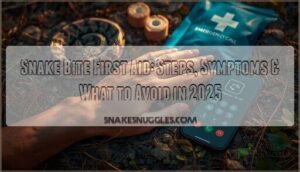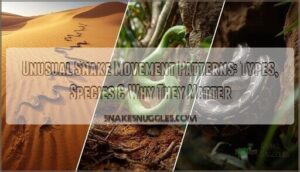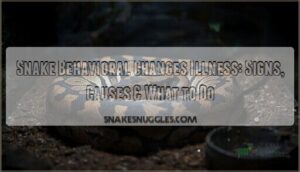This site is supported by our readers. We may earn a commission, at no cost to you, if you purchase through links.

A snake bite can happen in seconds, but what you do in the next few minutes determines whether you face a full recovery or serious complications. Most people panic and reach for outdated remedies they’ve seen in movies—cutting the wound, applying ice, or trying to suck out venom. These actions don’t just fail to help; they actively make things worse.
Snake bite first aid isn’t about heroics or folk wisdom. It’s about staying calm, protecting the bite site, and getting medical help fast. The difference between effective first aid and common mistakes often comes down to knowing three core principles: minimize movement, avoid interference, and seek professional treatment immediately.
Table Of Contents
- Key Takeaways
- Recognizing Snake Bite Symptoms
- Immediate Actions After a Snake Bite
- Essential First Aid for Snake Bites
- Critical Mistakes to Avoid After a Bite
- When and How to Seek Medical Help
- Frequently Asked Questions (FAQs)
- What is the first aid treatment for snake bites?
- What is the first thing to do for a snake bite?
- What 3 things should you do if bitten by a snake?
- What are the 7 principles of snake bite management?
- What is the first aid treatment for snake bite?
- What not to do after a snake bite?
- What is the first help snake bite?
- How long does it take for snake venom to act?
- Can you suck out snake venom from a bite?
- Are all snakes with triangular heads venomous?
- Conclusion
Key Takeaways
- Keep the bitten limb still and positioned at or slightly below heart level to slow venom spread through your lymphatic system while you wait for emergency medical care.
- Skip the Hollywood myths—don’t cut the wound, apply ice, use a tourniquet, or try sucking out venom, as these outdated methods cause tissue damage and waste critical minutes.
- Remove rings, watches, and tight clothing immediately before swelling starts, then cover the bite with a clean bandage and immobilize the limb with a splint.
- Call 911 right away for any snake bite, even if you’re unsure whether it was venomous, since symptoms like breathing difficulty or rapid swelling can appear hours later and require prompt antivenom treatment.
Recognizing Snake Bite Symptoms
Knowing what to watch for after a snake bite can make the difference between a good outcome and a serious medical crisis. Some symptoms show up right away at the bite site, while others affect your whole body and may take hours to develop.
Here’s what you need to recognize fast.
Local Pain, Swelling, and Bruising
Pain at the bite site often strikes within hours of envenomation, accompanied by swelling that can extend beyond the immediate area. You’ll likely notice bruising under the skin as tissue damage progresses. These symptoms signal your body’s inflammation response to the toxin.
Swelling severity often correlates with venom amount, making early recognition essential for effective first aid for snake bites and pain management.
Understanding the importance of methodological rigor is essential in scientific studies related to envenomation treatment.
Nausea, Vomiting, and Tingling
Systemic symptoms like nausea and vomiting can emerge within hours, even when swelling hasn’t appeared yet. You might feel tingling or numbness near the bite or beyond it—these neurotoxic reactions indicate venom effects spreading through your system.
Don’t dismiss these poisoning symptoms as stress alone. They require medical assessment to guide proper venom treatment and determine if antivenom is necessary.
Breathing Difficulties and Neurological Signs
As venom spreads, breathing problems can signal dangerous systemic reactions. Neurotoxic effects may start subtly—dizziness or facial weakness—then progress to respiratory failure if untreated. Watch for drooping eyelids, slurred speech, or difficulty swallowing.
These symptoms of envenomation demand immediate medical emergencies response. Venom-induced paralysis threatens your airway, making rapid toxin treatment with antivenom critical. Don’t wait for severe venom treatment delays; call for help now.
Identifying Fang Marks and Bite Patterns
After checking for breathing trouble, examine the bite itself. Venomous snakes leave two puncture wounds spaced about one to 1.5 centimeters apart—a telltale sign from fangs. Rattlesnake and coral snake bites show this V-shaped or parallel pattern. Swelling obscures marks quickly, so look early.
Fang mark analysis and bite pattern recognition help determine if you’re dealing with venom delivery mechanics requiring urgent wound assessment techniques.
Immediate Actions After a Snake Bite
The moments right after a snake bite determine how well your body copes with the venom. Your actions in the first few minutes can slow venom spread and prevent complications.
Your first actions after a snake bite can slow venom spread and prevent life-threatening complications
Here’s what you need to do immediately to protect yourself and improve your outcome.
Moving Away From The Snake Safely
Once you’re clear of striking range, your first priority is creating safe distance from the snake. Back away slowly without sudden movements that might provoke another strike.
Don’t turn your back or try to identify the species up close. Give the snake a clear retreat path toward cover, and monitor from a distance only.
These safe distance tactics help prevent repeat snakebite incidents.
Staying Calm and Reducing Movement
Panic speeds up your heart and accelerates venom spread through your body. Stay as still as possible and focus on slow, controlled breathing to keep your pulse steady.
Here are five calming techniques for snakebite first aid:
- Take deep, measured breaths to prevent hyperventilation and reduce heart rate
- Keep the bitten limb elevated slightly and completely still
- Avoid running or sudden movements that increase lymphatic flow
- Use gentle self-talk to maintain composure during this emergency
- Call for help while remaining stationary to limit envenomation effects
Removing Constricting Items
Rings, watches, and tight clothing can turn dangerous when swelling begins. Remove these items immediately but gently from the affected limb. If you encounter resistance or pain beyond gentle movement, stop and wait for medical help.
This constricting item removal is critical first aid for snakebite emergencies—swelling from venomous snakes can progress rapidly, and early safe jewelry removal prevents vascular compromise and aids in limb swelling prevention.
Positioning The Affected Limb Below Heart Level
Keep the bitten limb at or slightly below heart level to slow venom spread through your lymphatic system. This limb elevation technique in snake bite treatment helps limit circulation of toxins while you await emergency medicine support.
Avoid excessive elevation that compromises blood flow—comfortable positioning prevents venomous snakes’ venom from reaching essential organs quickly. Pressure immobilization bandaging combined with proper heart level positioning optimizes first aid effectiveness.
Essential First Aid for Snake Bites
Once you’ve taken the immediate safety steps, you need to focus on managing the bite site itself. Proper first aid can slow venom spread and reduce complications while you wait for medical help.
Here’s what you should do in those critical minutes after a snake bite.
Cleaning The Bite Area Properly
A simple rinse can prevent infection without making things worse. Gently wash the bite area with clean water and mild soap—don’t scrub hard or squeeze the wound. Avoid rubbing alcohol or hydrogen peroxide directly on the puncture marks. Your goal is to remove surface dirt without disrupting damaged tissue or spreading venom deeper.
- Run clean water over the bite for 30 seconds
- Use mild soap around (not in) the wound
- Pat dry with a clean cloth
Covering The Bite With a Clean Bandage
After patting the area dry, place a sterile dressing or clean cloth directly over the bite. This protects the wound from dirt and bacteria while you arrange transport.
Don’t wrap it tightly—your goal is a loose cover, not pressure immobilization bandaging for snake venom control. Replace the bandage if it gets wet or soiled during first aid.
Immobilizing The Affected Limb
Once you’ve covered the bite, restrict limb movement with a splint. Immobilizing the affected limb slows venom spread through your lymphatic system.
Secure a rigid support—a board, rolled magazine, or stick—alongside the arm or leg, extending past the joints above and below the bite. Fasten it with soft cloth, not too tight.
This splint application keeps the area still during emergency transport to medical care.
Monitoring for Worsening Symptoms
After splinting, watch for symptom escalation that signals emergency response needs. Venom effects can evolve rapidly, requiring immediate medical intervention.
Monitor these warning signs of envenomation:
- Swelling or pain spreading beyond the bite site
- Difficulty breathing, drowsiness, or confusion indicating neurotoxic symptoms
- Numbness, weakness, or chest tightness suggesting systemic toxicity treatment requirements
Patient monitoring continues until professional medical response arrives.
Critical Mistakes to Avoid After a Bite
When panic sets in after a snake bite, people often reach for outdated remedies that do more harm than good. These old-school tactics can worsen tissue damage, speed venom spread, or waste critical minutes you need for proper treatment.
Let’s clear up what never to do after a bite.
Dangers of Tourniquets and Cutting
Don’t apply a tourniquet or cut the snakebite wound. Tourniquets can cause tissue damage and nerve injury if left too long. Cutting introduces infection control problems and worsens local tissue damage from venomous snakes.
These emergency medical care mistakes can spread venom deeper through tissue planes. Both tourniquet risks and cutting dangers exacerbate toxicology complications rather than help first aid efforts.
Risks of Sucking Out Venom
Sucking out venom doesn’t work and creates new problems. Suction methods fail to remove meaningful toxin amounts while your mouth introduces bacteria that compromise infection control. Barotrauma risks include tissue damage around the bite from negative pressure.
- Mouth bacteria contaminate the wound and increase infection risk
- No clinical evidence shows suction methods reduce venom load
- Barotrauma can tear tissue and worsen local injury
- False confidence delays proper antivenom treatment
- Salivary enzymes may interact unpredictably with venomous snake toxins
This outdated first aid practice wastes critical time when you need emergency care most.
Avoiding Ice, Alcohol, and Caffeine
During snakebite treatment, skip ice, alcohol, and caffeine to prevent complications. Ice can cause tissue damage and mask critical snakebite symptoms. Alcohol risks dehydration and impairs emergency response to snakebites. Caffeine effects include elevated heart rate that worsens venom interactions.
These first aid mistakes delay proper medical treatment for snakebites—focus on immobilization and transport instead of ice alternatives.
Common Myths and Misconceptions
Many venom misconceptions persist despite public awareness efforts about venomous snakes. Fatal errors include believing all snakebites are deadly, that sucking venom works, or that tourniquets prevent spread.
These snakebite fallacies delay proper emergency response and first aid techniques. Not every bite needs antivenom—snakebite symptoms vary widely. Mythical treatments like ice or cutting the wound cause more harm than help.
When and How to Seek Medical Help
Every snake bite demands immediate medical evaluation, even if you’re uncertain whether the snake was venomous. Symptoms can appear hours after the bite, turning a seemingly minor injury into a life-threatening emergency.
Here’s what you need to know about getting help fast, understanding antivenom treatment, and protecting yourself in the future.
Signs Requiring Emergency Services
Call 911 immediately if any of these venomous bite symptoms appear—your swift emergency response can prevent respiratory failure signs or cardiac arrest:
- Sudden severe swelling or pain spreading beyond the bite within minutes
- Breathing difficulty, drooling, or hoarseness indicating airway compromise
- Collapse, fainting, or unconsciousness following the snakebite
- Racing heart, vomiting, or confusion suggesting systemic envenomation
- Paralysis or numbness moving beyond the bitten limb
These medical emergencies demand immediate emergency medicine intervention.
Importance of Prompt Antivenom Treatment
Getting antivenom into your bloodstream early dramatically changes treatment outcomes after venomous snakes inject toxins. Emergency response protocols prioritize venom neutralization within hours—antivenom dosage administered promptly halts systemic damage and reduces intensive care needs in medical emergencies.
Delayed toxicology and poisoning interventions can lead to irreversible tissue injury, so medical protocols emphasize immediate snakebite care over home remedies.
Describing or Photographing The Snake
If medical staff ask you to describe the snake, photo safety becomes essential—capture the image only from a safe distance to avoid triggering another snakebite. Focus on venomous snake identification features without approaching:
- Record color patterns that help distinguish rattlesnake from coral snake species
- Note scale texture and body shape for species classification
- Document habitat context including terrain and vegetation
- Capture approximate size without risking proximity
Your photo assists with venomous snakes recognition and proper antivenom selection.
Tips for Preventing Future Snake Bites
The best defense is preparation—wear thick boots and long pants in snake habitat areas to limit exposure. Shuffle your steps instead of swinging your feet to avoid hidden snakes in wilderness safety zones.
Stay on traveled trails for snakebite prevention.
| Prevention Strategy | Why It Works |
|---|---|
| Protective gear in outdoor safety zones | Reduces skin contact with ground surfaces |
| Night visibility with flashlight | Detects reflective eyes for early warning |
| Yard maintenance practices | Eliminates shelter near living spaces |
| Wildlife awareness on clear paths | Avoids tall grass where snakes hide |
Frequently Asked Questions (FAQs)
What is the first aid treatment for snake bites?
Unlike old-fashioned snake bite kits promoting venom removal, proper first aid focuses on staying calm, immobilizing the limb, removing constricting items, cleaning the wound gently, and seeking emergency response for antivenom and medical treatment.
What is the first thing to do for a snake bite?
Move away from the snake immediately to avoid a second bite. Call emergency services right away. Keep calm, stay still, and remove jewelry near the bite before swelling starts.
What 3 things should you do if bitten by a snake?
A snakebite demands swift emergency response. Move to safety immediately, keep the affected limb still and below heart level, and seek medical attention for potential antivenom administration. Don’t attempt venom extraction or wound cleaning beyond gentle rinsing.
What are the 7 principles of snake bite management?
Effective snakebite management relies on seven core principles: rapid emergency response, proper immobilization, avoiding harmful interventions, monitoring essential signs, timely medical treatment with antivenom, wound care, and long-term prevention through snake identification awareness.
What is the first aid treatment for snake bite?
When venom strikes, don’t panic—stay calm, remove tight items, immobilize the limb below heart level, gently wash the bite, cover it cleanly, and call emergency services immediately for proper medical treatment.
What not to do after a snake bite?
Don’t apply a tourniquet, cut the wound, or suck venom. Avoid ice, cold water, alcohol consumption, and caffeine. These first aid techniques worsen snakebite outcomes.
Seek immediate care—delayed care increases toxin management complications in wilderness medicine scenarios.
What is the first help snake bite?
Move away from the snake immediately, stay calm to slow venom spread, and call emergency help.
Remove jewelry near the bite before swelling starts, then keep the affected limb below heart level.
How long does it take for snake venom to act?
Symptoms can emerge within minutes to several hours after a snakebite. Venom onset times depend on venom potency, bite location, and snake species. Neurotoxic bites may show effects faster than hemotoxic venom effects.
Can you suck out snake venom from a bite?
No, don’t attempt to suck out snake venom. Medical guidelines confirm suction methods fail to extract toxin removal and worsen wound care by spreading venom absorption.
Snakebite myths like venom extraction delay proper treatment. It’s essential to understand the risks of venom extraction methods to provide effective first aid.
Are all snakes with triangular heads venomous?
No. Triangular heads don’t guarantee venom. Many nonvenomous snakes flatten their heads when threatened, mimicking venomous species.
Misidentifying snake species based solely on head shape myths increases triangular head risks during snakebite emergencies.
Conclusion
When seconds count, knowledge saves lives. Snake bite first aid isn’t complicated—it’s about doing the right things immediately and avoiding the wrong ones entirely.
Keep the victim calm, immobilize the limb, and get to a hospital without delay. Skip the tourniquets, ice, and old wives’ tales.
Your clear-headed response determines the outcome. Remember these steps, share them with others, and you’ll be ready if nature strikes without warning.
- https://x.com/godofprompt/status/1990526288063324577
- https://www.linkedin.com/posts/bohdanlukianets_tasks-study-research-activity-7373377539521667072-UTEi
- https://www.sciencedirect.com/science/article/pii/S0749208123000268
- https://arxiv.org/html/2507.17948v2
- https://academichelpexpress.blog/2024/08/please-use-the-bulleted-points-and-the-rubric-below-to-guide-your-work-your-pa/













